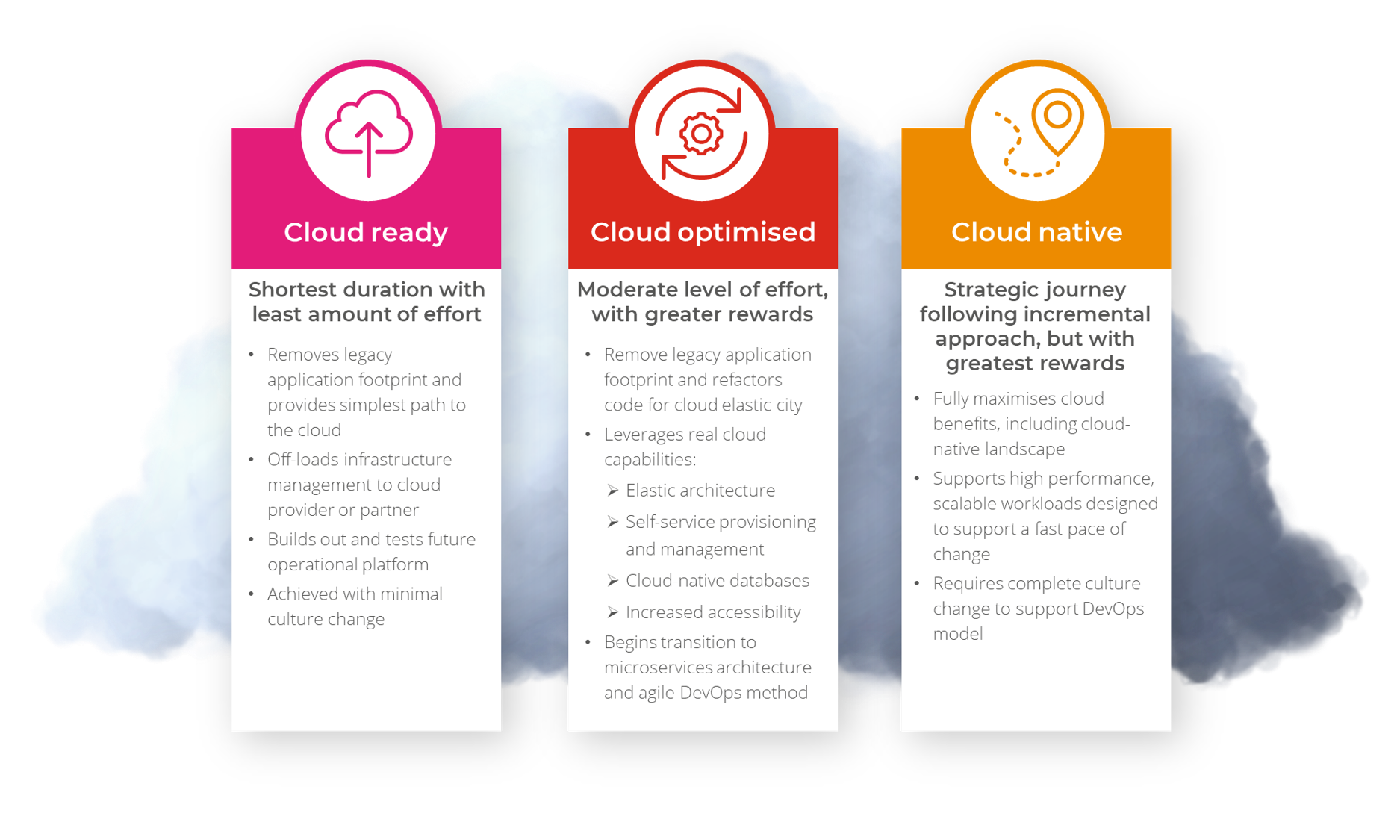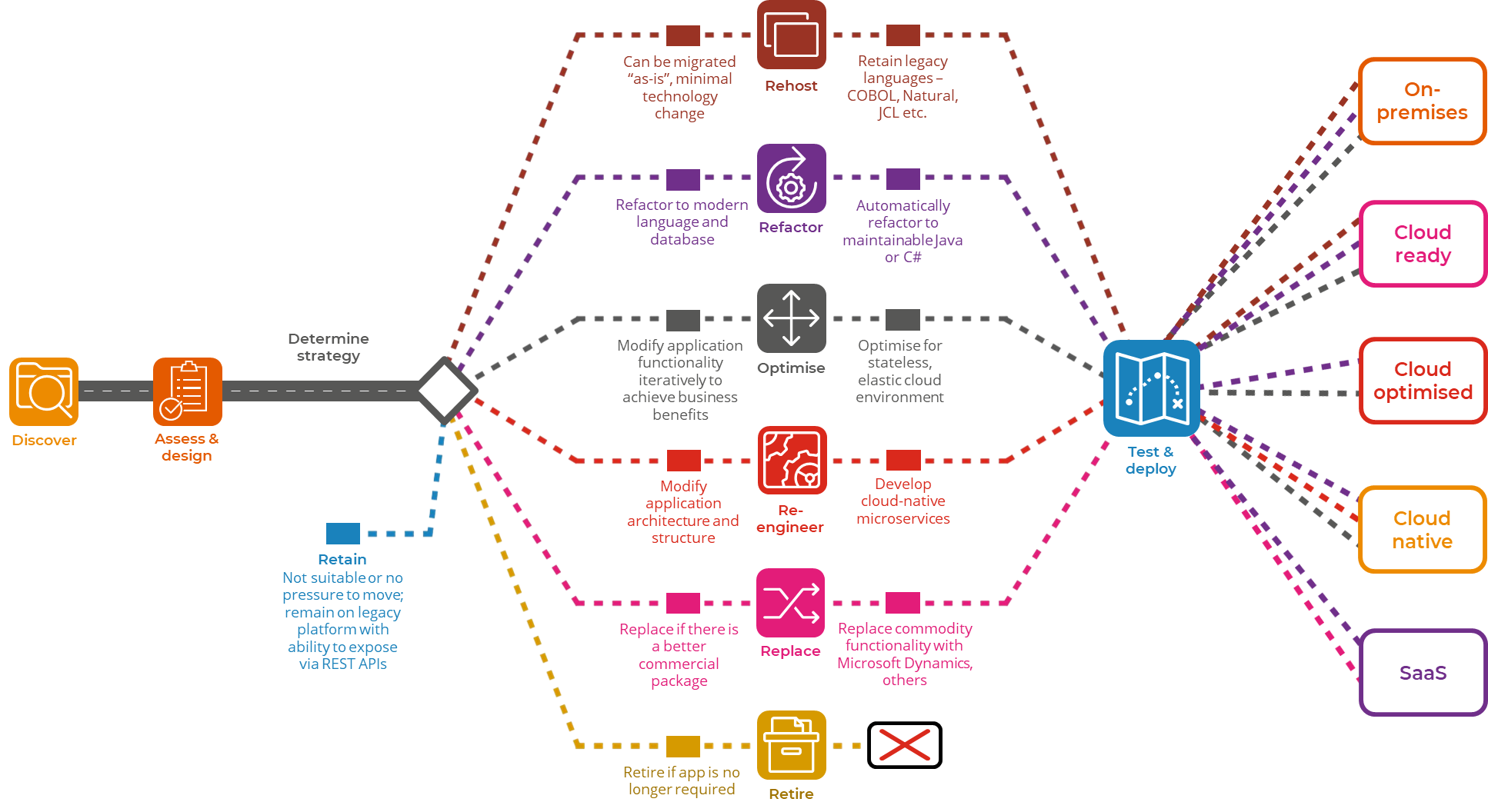A Guidepost for a Collaborative Modernisation Approach
Understand your short and long term cloud goals,
and formulate a strategy to achieve them
__________________________________________________
The drivers for moving workloads to the cloud are well documented: Organisations need to simplify operations, reduce costs, and increase application agility to meet market demands. Additional motivations for moving workloads to the cloud include balancing the need to meet regulatory compliance requirements with the desire to greatly increase innovation, performance, and scalability.
But the critical question for organizations to first answer is: What are the specific cloud destination options, and what is the recommended approach to get there? To be effective, organisations need a strategy that fully maximises cloud benefits, including, but not limited to, leveraging a cloud-native landscape.
Short and Long-Term Destination Options
LEGACY TO CLOUD
The selected cloud destination will ultimately depend on the customer’s desired short and long-term goals.
Advanced has the unique ability and experience to migrate legacy workloads to any cloud destination: cloud ready, cloud optimised, or cloud native. The below graphic provides an overview of the three different cloud destination options:

Disposition Strategies Mapped to Cloud Destinations
LEGACY TO CLOUD

The starting point of any modernisation journey should be a comprehensive assessment – encompassing applications, operations, and the supporting infrastructure. Assessment results should look to validate any pre-selected disposition strategies (sometimes referred to as modernisation patterns), and ultimately assist in defining the overall modernisation approach. Depending on the long term goals – the approach often includes a combination of disposition strategies. For example, a long term goal of re-engineering a large, complex mainframe monolith into cloud-native microservices can be broken into several incremental steps:
- Refactor applications to a cloud-native language such as Java or C# and run containerised in a cloud ready environment.
- Optimise applications to obtain desired level of elasticity at the container level, running in a cloud optimised environment. In parallel, re-engineer specific functionality identified during the assessment phase with Java-based microservices.
- Continue to optimise the application, incrementally re-engineering to microservices and progressing towards a cloud native environment, realising that it may not be necessary to replace the entire monolith in the short or long term. It’s important for each application to be analysed critically via an in-depth assessment in order to understand the reality that parts of the monolith might be better served remaining intact.
Disposition Strategies - An Overview
JOURNEY TO THE CLOUD
-
Rehost
A proven, mature approach based on an environment that runs on distributed platforms and emulates the legacy operating environment. The emulation capability minimises the amount of change that occurs when migrating legacy systems to a distributed platform. Source code is recompiled where possible, and customised to support the specific Rehost technology. Data is migrated – with the structure of some original data types retained, including Relational, VSAM, Sequential, GDGs, among others. Operational functionality provided by third party solutions such as job schedulers, print and output management, security, and systems management solutions are replaced in order to support the same processing capabilities as the original legacy environment.
-
Refactor
Our Automated Refactoring approach retains functional equivalence whilst converting core legacy applications to fully maintainable, refactored object-oriented Java or C# code. Once the legacy application and database is refactored, developers can extend application functionality directly without the need to navigate the original legacy code. Critical business logic from the legacy system is preserved, whilst enabling deeper integration with other Java or C# workloads and additional customisation to meet evolving business requirements.
-
Optimise
Various levels of optimisation can be applied during or following an Automated Refactoring project. Code is analysed during the assessment to determine application cloud-readiness and the required optimisation effort to obtain the desired level of elasticity (i.e. horizontal scalability [scale out/in] and vertical scalability [scale up/down]) required by the application workloads being migrated.
Because mainframe-based applications are stateful by nature, they require modifications in order to take advantage of the dynamic scaling abilities provided in a cloud-optimised environment. If scaling is desired, the assessment phase will allow for identification of areas where state is being stored on the application tier, such as the use of shared memory (e.g. CICS TS Queues, TD Queues, CWA, TWA if applicable) in addition to anywhere the applications are reading/writing local files, logs, and configuration scripts. At this point Advanced can provide customers with options that weigh the pros and cons for addressing each state-specific issue. Examples include leveraging a distributed cache to support state, and moving any local file access to a scalable shared file system.
-
Re-Engineer
Sometimes referred to as rewrite, re-engineering captures original application specifications, and then redesigns and develops the new solution using the latest application frameworks. In addition, re-engineering incorporates any required new functionality, which is a common driver for selecting this approach. Re-engineering delivers a completely customised solution that meets exact requirements, leveraging the latest application frameworks, architectures and practices such as cloud-native microservices and DevOps. The primary business outcome for re-engineering is increased application agility to more quickly meet evolving market demands.
ModPaaS, our bespoke modernisation solution, is available today on Amazon Web Services (AWS), Microsoft Azure, and Google Cloud marketplaces.
Additional resources to help you modernise
GUIDE
Modernisation secrets of the Fortune 1000
This paper highlights the drivers to modernise, and profiles three global businesses who leveraged Advanced solutions for success.
CASE STUDY
The New York Times: COBOL to Java
Advanced's Automated Refactoring solution enabled The New York Times to completely migrate their core IT system to an AWS platform.
REPORT
2022 Mainframe Modernisation Report
Exploring the impact of the new era of digitalisation and change on the current state of legacy systems and organisations' modernisation plans.
ON-DEMAND WEBINAR
Live discussion: 2022 Mainframe Modernisation Report
ON-DEMAND WEBINAR
Inside the largest modernisation in UK Government history
WHITEPAPER
Know the details, reduce the risk
How security is driving mainframe modernisation
Although the mainframe’s stellar reputation for security remains untarnished, there are some growing ancillary risks that are influencing platform decision-making.
02 Dec 2022 by Tim Jones, Managing Director of Application Modernisation, Advanced
How cloud migration can help your organisation to go green
Consider our best practices for moving to the cloud and reducing your organisation’s greenhouse gas emissions.
10 Jun 2021 by Rob Anderson, Vice President of Marketing and Product, Advanced
Why mainframe modernisation is a must with a multi-cloud strategy
This blog discusses how legacy modernisation can bring unmatched agility and power to your cloud deployments.
22 Sep 2021 by Rob Anderson, Vice President of Marketing and Product, Advanced
Additional insights to help you modernise
RESOURCES
-
2021 Mainframe Modernisation Report
Explore the the impact Covid-19 is having, and will continue to have, on modernisation plans, and the case for application modernisation amongst large enterprises with annual revenues over $1 billion.
Read report -
Know the details, reduce the risk
This whitepaper gives an in-depth explanation on why a detailed assessment of legacy applications and databases is essential for proper strategic modernisation planning and decision-making.
Read whitepaper
-
Live Discussion: The 2021 Mainframe Modernisation Business Barometer Report
Webinar Watch on demand -
How cloud migration can help your organisation to go green
Blog Read blog -
Know the details, reduce the risk: How to begin your mainframe modernisation journey
Webinar Watch on demand -
Struggling to adopt DevOps? Maybe it’s because of your aging mainframe
Blog Read blog
Contact an IBM representative

